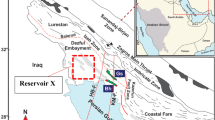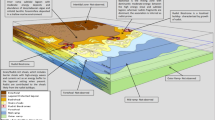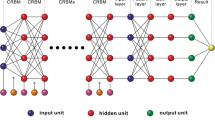Abstract
Ensuring accurate characterization of petroleum-bearing reservoirs is fundamental for successful exploration of hydrocarbon resources. Petrophysical models have been employed as solvers for quantitative evaluations of porosity, permeability, water saturation, and brittleness index. However, due to the high costs of well drilling, the core data obtained from limited wells are generally insufficient. Thus, most petrophysical models are generally impractical because of their unreliable employing coefficients determined statistically from insufficient core data. From the mathematical perspective, the popular petrophysical models reveal that porosity, permeability, water saturation, and brittleness index exhibit nonlinear fitting relationships with well logs. Thereby, the specific characteristics can be determined using a logging-based fitting. Light gradient boosting machine (LightGBM), a state-of-the-art regression technique, exhibits good performance. However, its performance depends on the support of favorable input and parametric optimization. To address this, continuous restricted Boltzmann machine (CRBM) and Bayesian optimization (Bayes) were integrated in this study, resulting in the proposed CRBM–Bayes–LightGBM framework. CRBM enhanced the input value by extracting significant features, while Bayes carried out the optimal initialization of hyperparameters of LightGBM. To comprehensively evaluate the proposed predictor, four experiments utilizing a dataset obtained from the tight sandstone reservoirs of the Ordos Basin were conducted. For further validation, five well-known regression models, including three-layer neural network, k-nearest neighbors, support vector regression, random forest, and extreme gradient boosting, were employed as competing models. An in-depth and comprehensive analysis of the experimental results yielded five key points: (1) The integration of CRBM and Bayes significantly enhanced the prediction performance of LightGBM; importantly, with the addition of geological regularization to mitigate the negative impact of mudstone during modeling, the fitting precision was further enhanced. (2) Compared to the five competing models, LightGBM-cored predictor yielded smaller fitting errors, establishing it as the best choice for petrophysical characterization. (3) LightGBM-cored predictor exhibited better generalization when trained using a larger dataset. (4) The application of transfer learning addressed the issue of under fitting in petrophysical characterization. (5) The proposed predictor demonstrated more robustness, as missing values in the training dataset do not hinder its feasibility.






















Similar content being viewed by others
Data availability
Data are available from the authors upon reasonable request.
Notes
*1 mD = 9.869233×–16 m2
References
Adeniran, A. A., Adebayo, A. R., Salami, H. O., Yahaya, M. O., & Abdulraheem, A. (2019). A competitive ensemble model for permeability prediction in heterogeneous oil and gas reservoirs. Applied Computing and Geosciences, 1, 100004.
Ali Ahmadi, M., Zendehboudi, S., Lohi, A., Elkamel, A., & Chatzis, I. (2013). Reservoir permeability prediction by neural networks combined with hybrid genetic algorithm and particle swarm optimization. Geophysical Prospecting, 61(3), 582–598.
AlsAnazi, A. F., & Gates, I. D. (2010). Support vector regression for porosity prediction in a heterogeneous reservoir: A comparative study. Computers and Geosciences, 36(12), 1494–1503.
Ao, Y., Li, H., Zhu, L., Ali, S., & Yang, Z. (2019). The linear random forest algorithm and its advantages in machine learning assisted logging regression modeling. Journal of Petroleum Science and Engineering, 174, 776–789.
Archie, G. E. (1950). Introduction to petrophysics of reservoir rocks. AAPG Bulletin, 34(5), 943–961.
Bagheripour, P. (2014). Committee neural network model for rock permeability prediction. Journal of Applied Geophysics, 104, 142–148.
Bagnardi, M., & Hooper, A. (2018). Inversion of surface deformation data for rapid estimates of source parameters and uncertainties: a Bayesian approach. Geochemistry, Geophysics, Geosystems, 19(7), 2194–2211.
Bai, J., Li, W., Liu, J., Wen, J., & Li, Z. (2022). The characteristics of sedimentary facies and reservoir of the Chang 8 member in Xunyi area Ordos Basin. Scientia Geologica Sinica, 57(1), 88–99.
Behnoud Far, P., Hosseini, P., & Azizi, A. (2017). Permeability determination of cores based on their apparent attributes in the Persian Gulf region using naive Bayesian and random forest algorithms. Journal of Natural Gas Science and Engineering, 37, 52–68.
Bengio, Y. (2009). Learning deep architectures for AI. Foundations and Trends in Machine Learning, 2(1), 1–27.
Bergstra, J., & Bengio, Y. (2012). Random search for hyper-parameter optimization. Journal of Machine Learning Research, 13, 281–305.
Breiman, L. (2001). Random forests. Machine Learning, 45(1), 5–32.
Candelieri, A., & Archetti, F. (2019). Global optimization in machine learning: the design of a predictive analytics application. Soft Computing, 23(9), 2969–2977.
Chen, H., & Murray, A. F. (2003). Continuous restricted Boltzmann machine with an implementable training algorithm. IEEE Proceedings: Vision, Image and Signal Processing, 150(3), 153–159.
Chen, Y., & Wu, W. (2017). Application of one-class support vector machine to quickly identify multivariate anomalies from geochemical exploration data. Geochemistry Exploration Environment Analysis, 17(3), 231–238.
Chen, L., Lin, W., Chen, P., Jiang, S., Liu, L., & Hu, H. (2021). Porosity prediction from well logs using back propagation neural network optimized by genetic algorithm in one heterogeneous oil reservoirs of Ordos Basin. China. Journal of Earth Science, 32(4), 828–838.
Chen, T., Guestrin, C., (2016). XGBoost: a scalable tree boosting system. In Proceedings of the ACM SIGKDD International Conference on Knowledge Discovery and Data Mining, 785-794.
Czarnecki, W. M., Podlewska, S., & Bojarski, A. J. (2015). Robust optimization of SVM hyperparameters in the classification of bioactive compounds. Journal of Cheminformatics, 7, 38.
Dekel, O., Gilad-Bachrach, R., Shamir, O., & Xiao, L. (2012). Optimal distributed online prediction using mini-batches. Journal of Machine Learning Research, 13, 165–202.
Eberhart, R.C., Shi, Y., (2001). Particle swarm optimization: developments, applications and resources. In Proceedings of the IEEE Conference on Evolutionary Computation, 81-86.
Gamal, H., & Elkatatny, S. (2022). Prediction model based on an artificial neural network for rock porosity. Arabian Journal for Science and Engineering, 47(9), 11211–11221.
Gao, J., Song, Z., Gui, J., & Yuan, S. (2022). Gas-bearing prediction using transfer learning and CNNs: an application to a deep tight dolomite reservoir. IEEE Geoscience and Remote Sensing Letters, 19, 3001005.
Gholanlo, H. H. (2021). Analysis of permeability based on petrophysical logs: comparison between heuristic numerical and analytical methods. Journal of Petroleum Exploration and Production, 11(5), 2097–2111.
Gu, Y., Bao, Z., & Cui, G. (2018). Permeability prediction using hybrid techniques of continuous restricted Boltzmann machine, particle swarm optimization and support vector regression. Journal of Natural Gas Science and Engineering, 59, 97–115.
Gu, Y., Zhang, D., & Bao, Z. (2021). A new data-driven predictor, PSO-XGBoost, used for permeability of tight sandstone reservoirs: a case study of member of Chang 4+5, western Jiyuan Oilfield, Ordos Basin. Journal of Petroleum Science and Engineering, 199, 108350.
Guo, Q., Zhuang, T., Li, Z., & He, S. (2021). Prediction of reservoir saturation field in high water cut stage by bore-ground electromagnetic method based on machine learning. Journal of Petroleum Science and Engineering, 204, 108678.
Hadavimoghaddam, F., Ostadhassan, M., Sadri, M. A., Bondarenko, T., Chebyshev, I., & Semnani, A. (2021). Prediction of water saturation from well log data by machine learning algorithms: boosting and super learner. Journal of Marine Science and Engineering, 9(6), 666.
Hinton, G. E. (2002). Training products of experts by minimizing contrastive divergence. Neural Computation, 14(8), 1771–1800.
Jiu, B., Huang, W., Li, Y., & He, M. (2021). Influence of clay minerals and cementation on pore throat of tight sandstone gas reservoir in the eastern Ordos Basin, China. Journal of Natural Gas Science and Engineering, 87, 103762.
Karimi, A. M., Sadeghnejad, S., & Rezghi, M. (2021). Well-to-well correlation and identifying lithological boundaries by principal component analysis of well-logs. Computers & Geosciences, 157, 104942.
Ke, G., Meng, Q., Finley, T., Wang, T., Chen, W., Ma, W., Ye, Q., Liu, T., (2017). LightGBM: a highly efficient gradient boosting decision tree. Advances in Neural Information Processing Systems, 3147-3155.
Kennedy, M. (2015). Log analysis part I: Porosity. Developments in Petroleum Science, 62, 181–207.
Koopialipoor, M., Noorbakhsh, A., Noroozi Ghaleini, E., Jahed Armaghani, D., & Yagiz, S. (2019). A new approach for estimation of rock brittleness based on non-destructive tests. Nondestructive Testing and Evaluation, 34(4), 354–375.
Krumbein, W. C., & Monk, G. D. (1943). Permeability as a function of the size parameters of unconsolidated sand. Transactions of the AIME, 151(01), 153–163.
Lai, J., Wang, G., Huang, L., Li, W., Ran, Y., Wang, D., Zhou, Z., & Chen, J. (2015). Brittleness index estimation in a tight shaly sandstone reservoir using well logs. Journal of Natural Gas Science and Engineering, 27, 1536–1545.
Lai, J., Wang, G., Wang, Z., Chen, J., Pang, X., Wang, S., Zhou, Z., He, Z., Qin, Z., & Fan, X. (2018). A review on pore structure characterization in tight sandstones. Earth-Science Reviews, 177, 436–457.
Li, C., Jiang, L., & Wu, J. (2009). Distance and attribute weighted k-nearest-neighbor and its application in reservoir porosity prediction. Journal of Information and Computational Science, 6(2), 845–851.
Li, P., Sun, W., Wu, B., Huang, R., Gao, Y., Yan, J., & Huang, H. (2019). Occurrence characteristics and main controlling factors of movable fluids in Chang 8 1 reservoir, Maling oilfield, Ordos Basin, China. Journal of Petroleum Exploration and Production Technology, 9(1), 17–29.
Liu, G. (2021). Challenges and countermeasures of log evaluation in unconventional petroleum exploration and development. Petroleum Exploration and Development, 48(5), 1033–1047.
Liu, J. J., & Liu, J. C. (2022). Permeability predictions for tight sandstone reservoir using explainable machine learning and particle swarm optimization. Geofluids, 2022, 2263329.
Liu, H., Zhao, Y., Luo, Y., Xiao, G., Meng, Y., Zhou, S., & Shao, L. (2020). Origin of the reservoir quality difference between Chang 8 and Chang 9 member sandstones in the Honghe oil field of the southern Ordos Basin, China. Journal of Petroleum Science and Engineering, 185, 106668.
Meng, F., Wong, L. N. Y., & Zhou, H. (2021). Rock brittleness indices and their applications to different fields of rock engineering: A review. Journal of Rock Mechanics and Geotechnical Engineering, 13, 221–247.
Moosavi, N., Bagheri, M., Nabi-Bidhendi, M., & Heidari, R. (2022). Fuzzy support vector regression for permeability estimation of petroleum reservoir using well logs. Acta Geophysica, 70(1), 161–172.
Naimi, S. R., Shadizadeh, S. R., Riahi, M. A., & Mirzakhanian, M. (2014). Estimation of reservoir porosity and water saturation based on seismic attributes using support vector regression approach. Journal of Applied Geophysics, 107, 93–101.
Nasseri, A., Mohammadzadeh, M. J., & Hashemtabatabaee, S. (2016). Evaluating Bangestan reservoirs and targeting productive zones in Dezful embayment of Iran. Journal of Geophysics and Engineering, 13(6), 994–1001.
Nelson, P. H. (1994). Permeability-porosity relationships in sedimentary rocks. Log Analyst, 35(3), 38–62.
Okon, A. N., Adewole, S. E., & Uguma, E. M. (2021). Artificial neural network model for reservoir petrophysical properties: Porosity, permeability and water saturation prediction. Modeling Earth Systems and Environment, 7(4), 2373–2390.
Olvera, H. A., Garcia, M., Li, W. W., Yang, H., Amaya, M. A., Myers, O., Burchiel, S. W., Berwick, M., & Pingitore, N. E. (2012). Principal component analysis optimization of a PM2.5 land use regression model with small monitoring network. Science of the Total Environment, 425, 27–34.
Otchere, D. A., Ganat, T. O. A., Gholami, R., & Lawal, M. (2021). A novel custom ensemble learning model for an improved reservoir permeability and water saturation prediction. Journal of Natural Gas Science and Engineering, 91, 103962.
Otchere, D. A., Ganat, T. O. A., Ojero, J. O., Tackie-Otoo, B. N., & Taki, M. Y. (2022). Application of gradient boosting regression model for the evaluation of feature selection techniques in improving reservoir characterisation predictions. Journal of Petroleum Science and Engineering, 208, 109244.
Pan, S. J., & Yang, Q. (2010). A survey on transfer learning. IEEE Transactions on Knowledge and Data Engineering, 22, 1345–1359.
Pan, S., Zheng, Z., Guo, Z., & Luo, H. (2022). An optimized XGBoost method for predicting reservoir porosity using petrophysical logs. Journal of Petroleum Science and Engineering, 208, 109520.
Poupon, A., & Leveaux, J. (1971). Evaluation of water saturation in shaly formations. Log Analyst, 12(4), 3–8.
Qadri, S. M. T., Islam, M. A., & Shalaby, M. R. (2019). Application of well log analysis to estimate the petrophysical parameters and evaluate the reservoir quality of the Lower Goru Formation, Lower Indus Basin, Pakistan. Geomechanics and Geophysics for Geo-Energy and Geo-Resources, 5(3), 271–288.
Qin, C., Zhang, Y., Bao, F., Zhang, C., Liu, P., & Liu, P. (2021). XGBoost optimized by adaptive particle swarm optimization for credit scoring. Mathematical Problems in Engineering, 2021, 6655510.
Qiu, L., Yang, S., Qu, C., Xu, N., Gao, Q., Zhang, X., Liu, X., & Wang, D. (2017). A comprehensive porosity prediction model for the upper Paleozoic tight sandstone reservoir in the Daniudi gas field, Ordos Basin. Journal of Earth Science, 28(6), 1086–1096.
Reeve, H. W. J., Cannings, T. I., & Samworth, R. J. (2021). Adaptive transfer learning. Annals of Statistics, 49(6), 3618–3649.
Sam-Marcus, J., Enaworu, E., Rotimi, O. J., & Seteyeobot, I. (2018). A proposed solution to the determination of water saturation: Using a modeled equation. Journal of Petroleum Exploration and Production Technology, 8, 1009–1015.
Seeger, M. (2004). Gaussian processes for machine learning. International Journal of Neural Systems, 14(2), 69–106.
Shao, R., Xiao, L., Liao, G., Zhou, J., & Li, G. (2022). A reservoir parameters prediction method for geophysical logs based on transfer learning. Acta Geophysica Sinica, 65(2), 796–808.
Shi, J., Lin, Y., Zhao, A., Wang, X., An, K., Zhong, X., Hu, K., Zhu, Y., & Liu, L. (2021). Diagenetic features and porosity dense evolution of Chang 8 tight sandstone reservoir in Hujianshan area, Ordos Basin. Journal of Petroleum Exploration and Production, 11(3), 1037–1051.
Snoek, J., Larochelle, H., Adams, R.P., (2012). Practical Bayesian optimization of machine learning algorithms. Advances in Neural Information Processing Systems, 2951-2959.
Sun, D., Lonbani, M., Askarian, B., Armaghani, D. J., Tarinejad, R., Pham, B. T., & Huynh, V. V. (2020). Investigating the applications of machine learning techniques to predict the rock brittleness index. Applied Sciences (Switzerland), 10(5), 1691.
Timur, A. (1968). An investigation of permeability, porosity, and residual water saturation relationship for sandstone reservoirs. Log Analyst, 9(4), 8–17.
Tukey, J., (1975). Mathematics and the picturing of data. In Proceedings of the International Congress of Mathematicians, 523-532.
Vargas-Guzmán, J. A. (2007). Spatial modeling of heterogeneous initial water saturation. Journal of Petroleum Science and Engineering, 58(1–2), 283–292.
Wang, M., Tang, H., Zhao, F., Liu, S., Yang, Y., Zhang, L., Liao, J., & Lu, H. (2017). Controlling factor analysis and prediction of the quality of tight sandstone reservoirs: a case study of the He8 Member in the eastern Sulige Gas Field, Ordos Basin, China. Journal of Natural Gas Science and Engineering, 46, 680–698.
Wang, R., Shi, W., Xie, X., Zhang, W., Qin, S., Liu, K., & Busbey, A. B. (2020). Clay mineral content, type, and their effects on pore throat structure and reservoir properties: Insight from the Permian tight sandstones in the Hangjinqi area, North Ordos Basin China. Marine and Petroleum Geology, 115, 104281.
Waxman, M. H., & Smits, L. J. M. (2003). Electrical conductivities in oil-bearing shaly sands. SPE Reprint Series, 55, 107–122.
Wold, S., Esbensen, K., & Geladi, P. (1987). Principal component analysis. Chemometrics and Intelligent Laboratory Systems, 2(1–3), 37–52.
Wood, D. A. (2020). Predicting porosity, permeability and water saturation applying an optimized nearest-neighbour, machine-learning and data-mining network of well-log data. Journal of Petroleum Science and Engineering, 184, 106587.
Wyllie, M. R. J., Gregory, A. R., & Gardner, L. W. (1956). Elastic wave velocity in heterogeneous and porous media. Geophysics, 21(1), 41–70.
Yang, L., & Shami, A. (2020). On hyperparameter optimization of machine learning algorithms: theory and practice. Neurocomputing, 415, 295–316.
Yasear, S. A., & Ku-Mahamud, K. R. (2021). Review of multi-objective swarm intelligence optimization algorithms. Journal of Information and Communication Technology, 20(2), 171–211.
Ye, Y., Tang, S., Xi, Z., Jiang, D., & Duan, Y. (2022). A new method to predict brittleness index for shale gas reservoirs: Insights from well logging data. Journal of Petroleum Science and Engineering, 208, 109431.
Zhang, D., Ranjith, P. G., & Perera, M. S. A. (2016). The brittleness indices used in rock mechanics and their application in shale hydraulic fracturing: a review. Journal of Petroleum Science and Engineering, 143, 158–170.
Zhang, Q., Wei, C., Wang, Y., Du, S., Zhou, Y., & Song, H. (2019). Potential for prediction of water saturation distribution in reservoirs utilizing machine learning methods. Energies, 12(19), 3597.
Zhou, K., Hu, Y., Pan, H., Kong, L., Liu, J., Huang, Z., & Chen, T. (2020). Fast prediction of reservoir permeability based on embedded feature selection and LightGBM using direct logging data. Measurement Science and Technology, 31, 045101.
Zhuang, F., Qi, Z., Duan, K., Xi, D., Zhu, Y., Zhu, H., Xiong, H., & He, Q. (2021). A comprehensive survey on transfer learning. Proceedings of the IEEE, 109, 43–76.
Acknowledgement
Thanks for the participation of Lin Xu, Qin Zuo, and Yinshan Gao in terms of reviewing and art work, which further improves the quality of the manuscript.
Author information
Authors and Affiliations
Corresponding author
Ethics declarations
Conflict of Interest
The authors declare that they have no known competing financial interests or personal relationships that could have appeared to influence the work reported in this paper.
Rights and permissions
Springer Nature or its licensor (e.g. a society or other partner) holds exclusive rights to this article under a publishing agreement with the author(s) or other rightsholder(s); author self-archiving of the accepted manuscript version of this article is solely governed by the terms of such publishing agreement and applicable law.
About this article
Cite this article
Gu, Y., Zhang, D., Xu, L. et al. Logging-Based Petrophysical Estimation for Tight Sandy-Mud Reservoirs Employing a Geologically Regularized Learning System. Nat Resour Res 33, 665–705 (2024). https://doi.org/10.1007/s11053-023-10289-y
Received:
Accepted:
Published:
Issue Date:
DOI: https://doi.org/10.1007/s11053-023-10289-y




